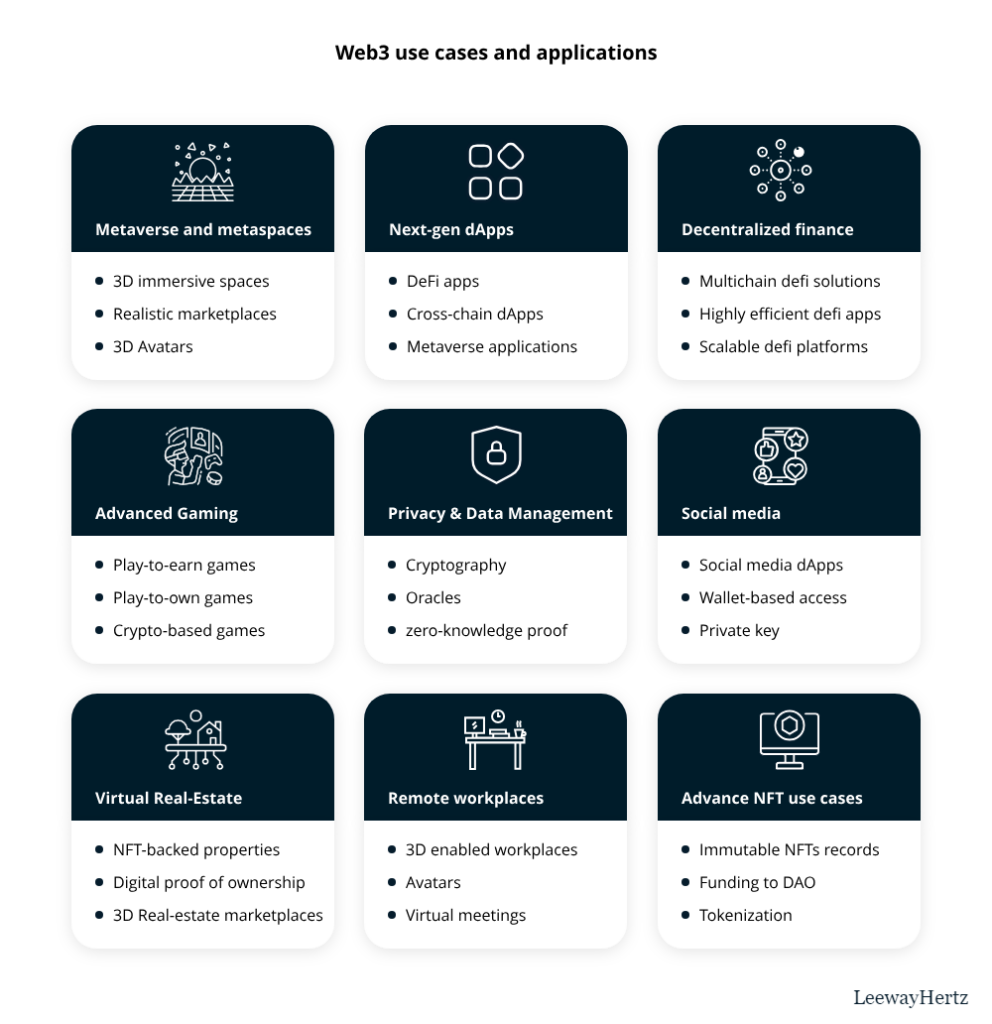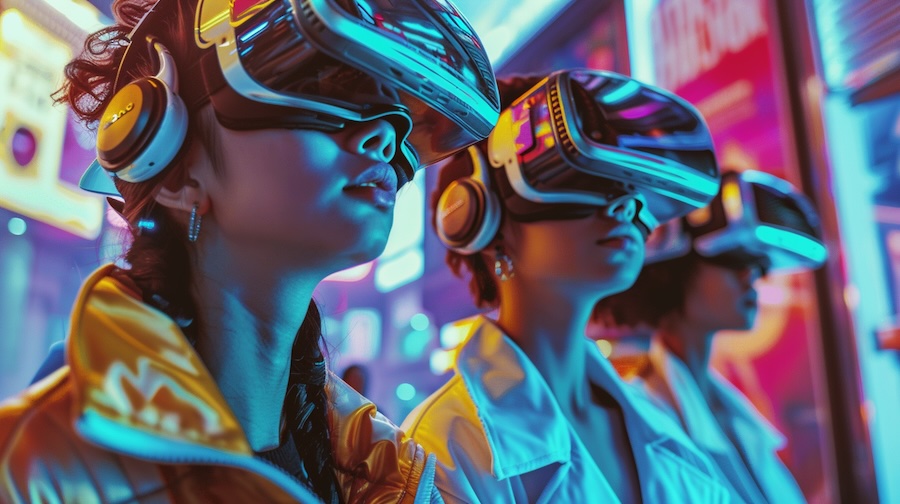We created this blog post for the EU-funded project “V2B: Creating NFT Opportunities on Metaverse for Art VET Trainees”, and our project reference number is 2022-1-DE02-KA210-VET-000080828. Coordinated by L4Y Learning for Youth GmbH in collaboration with Adana Cukurova Guzel Sanatlar and EMC Services Ltd, “The Revolution of Web3.0″ is prepared related to the training framework in the introduction post.
In ‘The Revolution of Web3.0’ where the internet has become an inseparable part of our lives, Web3.0 emerges as a paradigm shift in the development of the World Wide Web. The decentralized web, also known as the next phase, refers to the transition from a centrally controlled, commercially driven internet to a decentralized, community-powered web. This module serves as your gateway to understanding the fundamental concepts of Web3.0. Additionally, it provides an exploration of its practical applications, delves into the associated opportunities and challenges, and familiarizes you with the key players in the Web3.0 ecosystem.
The post is created for learners who are interested in emerging technologies, digital inventions, and the future of online relations. You can also find more blog posts in our R2 category. It is one of the posts.
Learning Objectives
By the end of this module, learners will be able to
- Define Web3.0 and its core technologies
- Identify current operations and use cases of Web3.0
- Estimate the openings and challenges associated with the relinquishment of Web3.0
- Develop an understanding of the Web3.0 ecosystem and its crucial players
The Revolution of Web3.0: An Overview
The Revolution of Web3.0 will give an overview of Web3.0 and its core technologies, including blockchain, decentralized operations (dApps), and smart contracts. Participants will learn about the main differences between Web3.0 and the traditional web, such as decentralization, sequestration, and security.This unit will also identify the benefits of Web3.0 i.e translucency, trust, and power.
Web3 is an identity layer for the internet. Web3 is a reaction to social networks not keeping the data secure and selling it for their profit. Web 3.0 is a way for artists and creators to not only own what they produce on a platform but also the platform itself.
Web3 is a collection of JS libraries that lets everyone interact with an Ethereum node in any way remotely or locally. Web 3 provides the community with an API to use so any user can easily work with the blockchain. Web3 works as a wrapper for JSON RPC to connect to a remote or local Ethereum node with either an HTTP or IPC connection. It can retrieve user accounts, send transactions, interact with smart contracts, and more.
Understanding The Revolution of Web3.0 requires a deep dive into its three fundamental pillars: decentralization, trustless and permissionless interaction, and reliance on smart technology, AI, and machine learning
Web 3.0 is based on three fundamentals:
- Decentralisation
- Trustless and Pesmissionless interaction
- Reliance on smart tech, AI and machine learning
Web3 represents the “next-iteration” of the internet- the evolution of web 1 (HTML-based static websites) and web 2 (dynamic, user-generated web). Web3 is an evolving concept as many changes are ongoing on its horizon. The majority of people are often confused while differentiating between web3 and web 3.0.
Read below these two concepts briefly:
Web 3.0- The semantic web
Web 3.0, denoting a semantic web, signifies a new phase where the term “semantic” entails the study of specialized language and logic. Tim Berners-Lee, the inventor of the World Wide Web, initially conceptualized Web 3.0 as an internet capable of autonomously interpreting and processing data without human intervention.
Web3- The decentralized web
Ethereum’s co-founder, Gavin Wood, developed the concept to stop the dominance of a centralised web where tech giants like Facebook, Twitter, and Google have the authority to collect and access users’ data. Web3 is powered by technologies such as blockchain, self-sovereign identity, and decentralised storage systems, transforming the traditional concept of data ownership and giving authority to the users.
Architecture of Web3
Delving deeper into The Revolution of Web3.0, we examine its unique architecture and how it differs from traditional web structures. Web3 represents a serverless internet architecture, generally called a decentralized web, that strives to provide data access and management rights to the users rather than any centralized entity. Web3’s architecture has five core layers, from layer 0 to layer 4.
Web3
- Firstly, decentralized data storage and data verification are achieved through distributed nodes.
- Additionally, users enjoy easy access with minimal data input requirements.
- Lower computational resources are needed due to the absence of intermediaries.
- Moreover, decentralized blockchain infrastructures are characterized by multiple nodes and networks.
- Importantly, there is no censorship in Web3 environments.
- Lastly, the decentralized structure ensures there is no single point of failure.
The Revolution of Web3.0: Applications and Use Cases of Web3.0
In this chapter, learners will have the opportunity to gain knowledge about the current operations and use cases of Web3.0. Furthermore, they will explore the decentralized finance (DeFi) ecosystem, non-fungible Tokens (NFTs), decentralized commerce, and decentralized social networks.
The Metaverse is a virtual realm that aims to blend the physical and digital universes. It comes in both centralized and decentralized forms, but the decentralized, web3-based Metaverse projects align better with the future’s needs. Leveraging the web3 ecosystem’s connectivity capabilities, Metaverse projects can provide users with an enriched, decentralized experience. . Additionally, Web3, powered by technologies like IoT and artificial intelligence, enhances the realism within the Metaverse.
Next-Generation Decentralized Applications (dApps)
In the web3 era, decentralized applications, or dApps, harness blockchain technology without centralized control. Moreover, dApps are designed to be feature-rich and user-friendly, spanning various domains like gaming, DeFi (Decentralized Finance), NFTs (Non-Fungible Tokens), and the Metaverse. Web3-driven dApps are genuinely decentralized and interoperable, although interoperability isn’t always a prerequisite in the blockchain ecosystem unless the project dictates it.
The Evolution of Decentralized Finance (DeFi)
DeFi takes advantage of web3 attributes to enhance its existing infrastructure and capabilities. Enterprises can blend DeFi technology with the open and robust web3 ecosystem to develop futuristic DeFi solutions and applications. Furthermore, Web3 brings several benefits to DeFi, including access to an open-source environment, reduced transaction fees, efficient transaction processing, and more transparent and automated governance.
Advanced Gaming in the Web3 Era
Web3 games represent the next level of blockchain-based gaming, encompassing play-to-earn, NFT, and play-to-own games. Moreover, these web3 games incorporate blockchain, NFTs, and underlying gaming infrastructure, paving the way for next-gen games where players can own, trade, and create in-game assets to generate income. Notable examples include Axie Infinity and Decentraland. As the web3 landscape evolves, web3 games will undergo significant transformations.
Privacy and Data Management
While blockchain promotes transparency, complete transparency can raise privacy concerns. Web3 empowers blockchain infrastructure to implement innovative concepts like cryptography and zero-knowledge proofs. Consequently, this ensures enhanced privacy in decentralized digital environments.
The Dawn of Web3 social media
Web3 heralds a new era of social media emphasizing a creator-driven economy and granting users ownership of their content instead of centralized entities. Web3 social media apps represent the next iteration of today’s platforms like Facebook, Instagram, and Snapchat. Unlike traditional platforms, they offer users anonymous access via wallet addresses and private keys. This marks a significant departure from data submission to centralized entities.
Virtual Real Estate in the Web3 World
The real estate industry has undergone significant transformation due to the emergence of NFTs, blockchain technology, and the Metaverse. Within the robust ecosystem of Web3, modern projects are emerging in the real estate sector. These projects utilize NFTs, virtual reality, and 3D technology to verify ownership and transfer NFT-based real estate properties.
Web3-Powered Remote Workplaces
Web3 technologies empower companies to create 3D virtual workplaces, consequently transforming traditional physical offices. Employees’ avatars inhabit these virtual spaces, enabling interactions with colleagues and engaging in activities similar to real-world workplaces.
Advancing NFT Use Cases
NFTs, pivotal in the blockchain realm, have myriad applications in the web3 ecosystem. They not only incentivize audiences but also confer digital ownership, recording immutable data on the blockchain. Moreover, organizations and businesses are harnessing NFTs to raise capital by tokenizing their entities. Additionally, they offer blockchain-based exclusivity and ownership while fostering decentralized autonomous organizations (DAOs) or online communities owned by members.

Source: https://www.leewayhertz.com/
Opportunities and Challenges of Web3.0 Adoption
This chapter will furnish participants with an overview of the opportunities and challenges linked to Web3.0. They will delve into the implicit benefits of Web3.0 for businesses, such as increased effectiveness, lower costs, and new profit avenues.
Web3.0, often referred to as the decentralized web or the semantic web, represents the next phase in the evolution of the internet. It introduces a range of exciting opportunities and challenges for both users and businesses. Here are some of the key opportunities and challenges of Web3.0 adoption:
Opportunities:
Decentralization: Web3.0 is built on blockchain and decentralized technologies, thereby eliminating the need for a central authority controlling data and applications. Consequently, this can lead to increased trust and security as users have more control over their data.
Data Ownership:Moreover, users have greater control over their personal data and can choose how it is shared, thereby leading to improved privacy and reduced data exploitation by tech giants.
Interoperability: Furthermore, Web3.0 aims to make data and applications more interoperable across platforms, thus enhancing user experiences and streamlining business processes.
Smart Contracts: Smart contracts enable self-executing agreements, automating processes and reducing the need for intermediaries in various industries, such as finance, supply chain, and legal.
Digital Identity: Furthermore, Web3.0 could offer improved digital identity solutions, thereby making online identity more secure and user-friendly.
Tokenization: Additionally, assets of all kinds, from art to real estate, can be tokenized, making them more accessible for investment and trading.
Incentive Mechanisms: Moreover, cryptocurrencies and tokens can be used to incentivize users and developers, potentially fostering innovation and collaboration.
Challenges:
Scalability: Firstly, current blockchain technologies have scalability issues, leading to slow transaction times and high fees. This limits their suitability for widespread adoption.
Regulatory Uncertainty: Governments around the world are still grappling with how to regulate Web3.0 technologies, leading to uncertainty for businesses and investors.
User Experience: Additionally, Web3.0 applications can be complex and challenging for non-technical users, hindering mass adoption.
Energy Consumption: Lastly, some blockchain networks, like Bitcoin, are criticized for their energy consumption, raising concerns about their environmental impact.
Security: While blockchain is touted for its security, it’s not immune to vulnerabilities. Smart contract bugs and hacking incidents have led to significant losses.
Lack of Standards: In addition, the absence of clear standards can impede interoperability and hinder the growth of the Web3.0 ecosystem.
Adoption Hurdles: Moreover, moving from Web2.0 to Web3.0 involves a significant transition. It requires users to adapt to new technologies and concepts, which can be a slow and challenging process.
Legal and Ethical Issues: Decentralized systems can give rise to legal and ethical dilemmas, such as disputes over digital assets and the challenge of enforcing regulations in a decentralized environment.
How can we tackle the Web3 Challenges?
To tackle the hurdles faced by Web3 technology, the first step involves enhancing the user interface and experience (UI/UX). A user-friendly interface can alleviate confusion among users, making their journey smoother. Additionally, leveraging existing Web2 standards and adapting them for the Web3 ecosystem can facilitate this transition.
Furthermore, ensuring seamless interaction among various platforms and hassle-free smart contract audits is crucial. Timely issue resolution and third-party testing bolster platform reliability. To pave the way for Web3 adoption, educational content remains pivotal. Increased awareness contributes to broader Web3 accessibility.
Summing it up:
Despite its promise, challenges persist in the Web3 landscape. Many Web3 projects have lost their market value, and creators grapple with establishing novel utilities. For Web3 products to succeed, their use cases must be crystal clear to the masses. Users need to understand the problems these products solve and how they can benefit from them. Entrepreneurs who identify market issues and develop user-friendly solutions are in high demand.
Moreover, people are willing to pay for convenience and problem-solving. No one wants a frustrating experience. Therefore, for Web3 to gain widespread acceptance, user experience must be a top priority.
Education is equally vital for Web3 adoption. Informative content about navigating dApps and various Web3 projects should be readily available to everyone, not just those immersed in blockchain technology.
Moreover, acknowledging Web3 challenges and highlighting Web2 benefits doesn’t imply that Web2 is free from issues. It has simply gained more mainstream traction, with solutions addressing the masses’ needs. To ensure Web3’s mainstream adoption in 2023, builders and adopters must collectively tackle its ongoing challenges. Furthermore, the more users embrace decentralized technology, the more Web3 will flourish.
Addressing Web3 Challenges: Strategies to Consider
- Scalability:
- Research and develop new consensus mechanisms and layer 2 solutions to boost transaction speed and reduce fees.
- Additionally, invest in projects dedicated to enhancing blockchain scalability and performance.
- Regulatory Uncertainty:
- Collaborate with regulators and policymakers to establish clear, balanced frameworks for Web3.0 tech.
- Furthermore, participate in industry associations and advocacy groups to represent Web3.0 community interests.
- User Experience:
- Prioritize user-centric design to create intuitive, accessible Web3.0 applications.
- Moreover, invest in education and user onboarding for better user understanding of decentralized tech.
- Energy Consumption:
- Explore energy-efficient consensus mechanisms like Proof of Stake (PoS) or Proof of Authority (PoA).
- Additionally, support sustainable blockchain and green energy projects.
- Security:
- Conduct rigorous code audits and security testing for smart contracts and blockchain protocols.
- Promote security awareness and best practices within the Web3.0 community.
- Lack of Standards:
- Collaborate with industry leaders, developers, and standardization bodies to establish interoperability standards.
- Encourage open-source development and contribute to interoperability projects.
- Adoption Hurdles:
- Provide user-friendly tools that simplify blockchain technology.
- Create educational content, tutorials, and workshops to guide users through the Web3.0 ecosystem.
- Legal and Ethical Issues:
- Engage legal experts and regulatory teams to navigate legal challenges and ensure compliance.
- Establish community-driven governance to address ethical matters in decentralized environments.
- Incentivizing Innovation:
- Fund research, hackathons, and incubators focused on Web3.0 technologies.
- Foster a collaborative developer community to drive innovation.
- Community Engagement:
- Encourage an inclusive, diverse community actively shaping the Web3.0 ecosystem.
- Gather feedback from users, developers, and stakeholders to continually enhance the technology.
Embracing these strategies and fostering a collaborative, forward-thinking approach will empower the Web3.0 community to conquer challenges and unleash the full potential of this transformative technology.
The Revolution of Web3.0: Conclusion
As we conclude our insights into The Revolution of Web3.0, we reflect on the transformative impact and future potential it holds. In conclusion, ‘The Revolution of Web3.0’ module has illuminated the transformative potential of Web3.0. We’ve delved into the emerging phase of the internet’s evolution, characterized by decentralization, blockchain technology, and groundbreaking innovations. Web3.0, rooted in principles of decentralization, trustless interactions, and smart technology reliance, holds significant promise.
The module introduced us to its foundations, encompassing blockchain, dApps, and smart contracts, emphasizing the distinctions from the traditional web, highlighting transparency, trust, and empowerment. Chapter 2 unveiled the practical applications of Web3.0, spanning DeFi, NFTs, advanced gaming, and virtual real estate, harnessing technologies like IoT and AI for immersive experiences. Chapter 3 provided a comprehensive view of the opportunities and challenges in Web3.0 adoption, with opportunities including decentralization, data ownership, interoperability, and innovative technologies like smart contracts and digital identity. Challenges such as scalability, regulatory uncertainty, and user experience were addressed, with proposed strategies such as UI/UX enhancement and education. Web3.0 offers transformative potential, contingent on collective efforts to surmount obstacles and foster an inclusive, user-friendly ecosystem. Embracing Web3.0 denotes a journey into a decentralized digital frontier characterized by innovation and exploration.
References and Resources
- Buterin, V. (2014). A next-generation smart contract and decentralized application platform. Ethereum.
- Habermeier, K., & Christopher, B. (2020). Understanding Web 3: A user-centered guide to the decentralized internet.
- Swan, M. (2015). Blockchain: blueprint for a new economy. O’Reilly Media, Inc.
- Tapscott, D., & Tapscott, A. (2018). Blockchain revolution: How the technology behind bitcoin is changing money, business, and the world.
- Wood, G. (2014). Ethereum: A secure decentralized transaction ledger. Ethereum.
- Dr. Ravi Chamria, WHAT CHALLENGES LIE AHEAD IN THE ADOPTION OF WEB3 IN 2023? nasscom community, January 10, 2023, https://community.nasscom.in/communities/blockchain/what-challenges-lie-ahead-adoption-web3-2023










